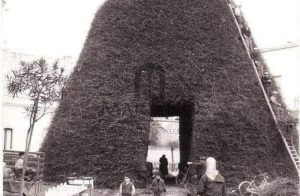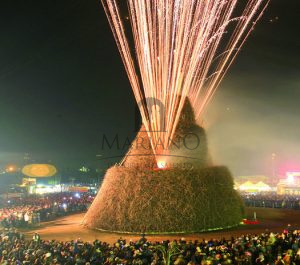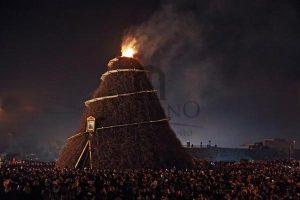In the heart of January, the province of Lecce comes alive to celebrate an event of extraordinary cultural and religious significance: the Feast of Saint Anthony the Abbot, a deeply rooted tradition in the town of Novoli, in northern Salento. This event is a melting pot of history, legends, popular traditions, and devotion, culminating in a unique and spectacular blend.

Who was Saint Anthony the Abbot?
Saint Anthony the Abbot, who lived in the 3rd century AD, was a wealthy Egyptian heir born into a Christian family. He chose to renounce all material possessions to live in the desert in poverty, dedicating himself to prayer and contemplation. Other men who sought to follow his example gathered around him, forming a community of hermits. The saint, who lived to the age of 105, is invoked as the protector of animals and those afflicted by the plague, partly due to the many legends surrounding him. One of the most famous tells of a sick piglet healed by the saint, which became his inseparable companion.
renounce all material possessions to live in the desert in poverty, dedicating himself to prayer and contemplation. Other men who sought to follow his example gathered around him, forming a community of hermits. The saint, who lived to the age of 105, is invoked as the protector of animals and those afflicted by the plague, partly due to the many legends surrounding him. One of the most famous tells of a sick piglet healed by the saint, which became his inseparable companion.
The figure of Saint Anthony the Abbot is closely associated with fire, a symbolic element of purification and renewal. According to legend, the saint descended into hell to confront Satan and steal fire to give it to mankind. This connection with fire is reflected in the tradition of bonfires, which are lit on the night of January 17th to burn away the past year’s evils and welcome the new year with positive energy. The Fòcara of Novoli, the largest bonfire in the Mediterranean and Europe, is the emblem of this tradition.

The Fòcara: Between Rural Art and Modernity
For over three centuries in Novoli, the Fòcara has been skillfully built by the pignunai, expert craftsmen who use approximately 100,000 bundles of vine trimmings collected during vineyard pruning. This monumental structure, over 25 meters tall and about 20 meters in diameter, is the result of the efforts of one hundred volunteers working together for weeks. At the top of the structure, an effigy of the saint is placed, which burns during the lighting, accompanied by a captivating fireworks display.
100,000 bundles of vine trimmings collected during vineyard pruning. This monumental structure, over 25 meters tall and about 20 meters in diameter, is the result of the efforts of one hundred volunteers working together for weeks. At the top of the structure, an effigy of the saint is placed, which burns during the lighting, accompanied by a captivating fireworks display.
The Novoli festival takes place from January 16th to 18th and includes the traditional lighting of the Fòcara on the evening of January 16th. This moment is preceded by the intorciata procession, during which the statue of the saint is carried through the streets of the town by the faithful. The square fills with thousands of people who gather to witness the burning of the wooden structure, an event symbolizing hope and renewal. The atmosphere is enriched by Salento folk music and the spectacle of the fasciddre, sparks that create an enchanting “rain of fire.”

Over time, the shape of the monumental pyre has also evolved, becoming increasingly imposing and majestic. However, what takes place in the village just outside Lecce is an ancient, propitiatory rite that stretches back into the mists of time. In fact, scholars are still searching for its origins—its “zero date,” so to speak.
takes place in the village just outside Lecce is an ancient, propitiatory rite that stretches back into the mists of time. In fact, scholars are still searching for its origins—its “zero date,” so to speak.
According to some sources, the Fòcara was first lit in 1905, when “a heavy snowfall blanketed the bonfire on the eve of the celebration.” What is certain is the fame of the world’s largest “good fire,” which lights up and warms the night of January 16th. Its renown has surpassed the borders of this small village of just over nine thousand residents, becoming increasingly national and cosmopolitan.
The Feast of Saint Anthony the Abbot is much more than a religious event. Over the years, it has transformed into a true cultural and tourist attraction. With over 80,000 spectators annually, “The Days of Fire” serve as a gathering point for the agricultural community, an opportunity to promote local food and wine, and a means to highlight the Negroamaro Park.

The Fòcara of Novoli has been recognized as an element of intangible cultural heritage by the Region of Puglia and aspires to be included on UNESCO’s list of Intangible Cultural Heritage of Humanity. Over the years, internationally renowned artists have contributed to making this event even more extraordinary with artistic installations that have enriched the town’s cultural heritage. Among these are notable installations created

for the Fòcara, such as Mimmo Paladino’s papier-mâché horses, Ugo Nespolo’s colorful numbers, Hidetoshi Nagasawa’s concept of an external wooden spiral culminating at the top of the bonfire, symbolizing a peak reaching toward the universe and uniting Western and Eastern cultures, and Jannis Kounellis’s installation of a cross made with large stones and numerous iron lances placed on the Fòcara.
These and many other artists have donated signature posters of their works, further enriching Novoli’s cultural repositories, such as the “Pinacoteca di Arte Contemporanea” (Contemporary Art Gallery) and the “Museo del Fuoco” (Museum of Fire). Other notable figures, including Letizia Battaglia, Juliano Lucas, Edoardo Winspeare, Emir Nemanja Kusturica, and Tony Gentile, along with many others, have elevated this event to exceptional levels, both religiously and economically and culturally.
In January 2020, during the traditional Fòcara of Novoli, the Baronial Palace hosted a contemporary art exhibition. The display featured works by internationally acclaimed artists with the aim of creating a dialogue between modern art and local traditions. The exhibition enriched the Fòcara’s cultural program, emphasizing the importance of contemporary art within the context of popular celebrations.
Conclusions
The Feast of Saint Anthony the Abbot in Novoli is a unique event that seamlessly combines tradition and modernity. The Fòcara is not just a symbol of devotion but also a vessel of culture and identity for the entire community. Participating in this celebration means immersing oneself in a world of stories, legends, and traditions that reflect the most authentic soul of Salento.



